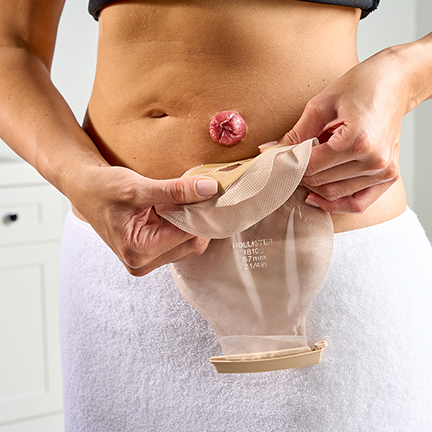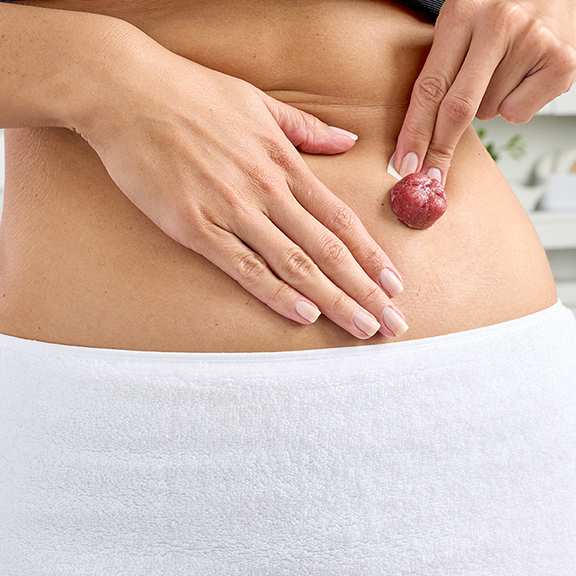How To Solve Common Ostomy Problems: A Troubleshooting Guide
Many people believe that skin issues, leaks and other problems are unavoidable parts of living with a colostomy, ileostomy or urostomy. That’s not true! There are simple solutions for most ostomy issues that can improve your health, your confidence, and your quality of life.
Here are some of the most common problems people encounter with their ostomy, with tips for solving them.
Problem: My ostomy pouch keeps detaching
Possible solutions:
- Empty your pouch more often. The weight of a too-full pouch can pull the ostomy system away from the skin. It’s usually best to empty the pouch when it’s 1/3 to 1/2 full.
- Change your pouching system more often. People typically replace their pouching system twice a week, but your schedule will depend on your personal preferences for wear time.
- If your ostomy pouch is detaching because it’s ballooning (filling with gas), you can uncover the filter, release gas from the pouch at intervals during the day, avoid gas-inducing foods (such as onions, cabbage or beans), and avoid drinking with meals.
- If output is getting stuck at the top of your ostomy pouch (pancaking), try using lubricating drops in your pouch.
- Check for leaks. Any leakage will weaken the adhesion and may damage your skin, too.
- Wash your peristomal skin only with water and/or gentle soap. Using lotions, creams or ointments in this area can prevent your ostomy skin barrier from adhering.
- Wear an ostomy belt or supportive garment. These help to hold the ostomy pouching system in place.
- Switch to a different brand or type of ostomy pouching system. If the flange of your two-piece pouching system keeps detaching, try a one-piece system instead.


Problem: My ostomy pouching system is leaking
Possible solutions:
- Empty your pouch when it’s 1/3 to 1/2 full. The weight of a too-full pouch can pull the ostomy system away from the skin and cause leaks.
- Use a stoma measuring guide to ensure a precise fit when you’re applying a new ostomy pouching system. The gap between your stoma and the edge of the opening in the skin barrier should be no more than 1/8”.
- Wash your peristomal skin only with water and/or gentle soap and dry it thoroughly. Using lotions, creams or ointments in this area can prevent your ostomy skin barrier from adhering. If your peristomal skin is raw or weeping, use stoma powder or try the crusting technique to protect it when attaching your ostomy system.
- Often, leaks occur because the peristomal skin isn’t completely smooth. If you have any scars, creases or irregularities that prevent the skin barrier from forming a tight seal, use ostomy accessories (such as barrier rings and stoma paste) to fill the gaps.
- If your stoma is retracted or flush with the skin, try a convex barrier ring to get a leakproof fit.
Problem: My ostomy pouching system is pancaking (the output is getting stuck at the top)
Possible solutions:
- Wear looser clothing to prevent pressure on the pouching system.
- You can blow air into the ostomy pouch before applying it. This doesn’t work if your pouch has a filter, however.
- Roll a few sheets of toilet paper into a little tube and insert it into your pouch. This can help prevent the pouch from collapsing.
- If your pouch’s filter is evacuating too much air and causing a vacuum effect, you can cover it with a sticker or a piece of tape.
- Add lubricating drops to help the contents of your ostomy pouch flow to the bottom of the pouch. Pouch lubricant also makes it easier to empty your ostomy pouch and reduces odor when doing so.
Read more: How to Use Ostomy Pouch Lubricating Drops


Problem: The skin around my stoma is red, raw and/or irritated
Possible solutions:
- Check for leaks. The output from an ostomy can damage the peristomal skin, if it leaks under the skin barrier.
- When removing your ostomy pouching system, do it slowly and gently to avoid stripping the skin. Use an adhesive remover, if needed.
- When changing your ostomy pouching system, wash your peristomal skin only with water and/or gentle soap and dry it thoroughly.
- Use a stoma measuring guide to ensure a precise fit when you’re applying a new ostomy pouching system. To prevent leaks, the gap between your stoma and the edge of the opening in the skin barrier should be no more than 1/8”.
- Change your ostomy products if they’re causing irritation. Try a different pouching system, or a barrier ring instead of stoma paste.
- Use stoma powder or the crusting technique to protect raw, weeping skin and allow it to heal.
- Don’t hesitate to reach out to your wound, ostomy, and continence (WOC) nurse for help and guidance. If you’re experiencing a painful or serious peristomal skin condition, contact your healthcare provider right away.
Read more: How to Care for Your Peristomal Skin
Problem: I’m worried about odor with my ostomy pouching system
- Look for leaks around your skin barrier. Modern pouching systems are designed to trap and contain odors, so you shouldn’t smell anything while you’re wearing one.
- Empty your pouch regularly, when it’s 1/3 to 1/2 full.
- To reduce odor when emptying your pouch, use lubricating deodorant drops.
- Adjusting your diet can reduce the odor of your ostomy output. Reduce or avoid any foods or beverages that are likely to cause strong odors, such as onions, garlic, broccoli, asparagus, cabbage, Brussels sprouts, fish, cheese, eggs, beans, and alcohol. Foods that can reduce odor include parsley, yogurt, and buttermilk.
- If gas is an issue, choose an ostomy pouching system with a filter. Try not to swallow air with your food, avoid carbonated drinks, and don’t eat foods that make you gassy.
- If urine odor is an issue with a urostomy, try drinking more water and/or cranberry juice. Avoid foods that can cause a strong odor, like asparagus.


Problem: I’m worried people will notice my ostomy pouching system
- Choose a lower-profile ostomy pouching system. One-piece ostomy pouching systems typically lie flatter and are less noticeable than two-piece systems.
- Try different clothing combinations. You don’t have to wear extra-loose, baggy clothes — patterned fabrics, darker fabrics, high-rise pants and layers all can help conceal an ostomy pouch.
- Wear an ostomy wrap, which is a stretchy band that supports your pouching system and holds it snugly against your body.
- If you’re planning to swim or exercise, look for specialty ostomy-concealing activewear. Women can try patterned or ruched swimsuits, while men may consider higher-waisted trunks.
Related Products
Sources
Find Solutions to Problems That Can Occur With an Ostomy (United Ostomy Associations of America)
Food Reference Chart for People with an Ostomy (United Ostomy Associations of America)
Why Does My Stoma Bag Keep Coming Off? (CliniMed)
6 Tips for Avoiding Ostomy Leakage (Hollister)
Tips and Tricks to Avoid Ostomy Pancaking (Shield Healthcare)
Ileostomy and Your Diet (MedlinePlus.gov)
Concealing Your Appliance (GI Society)

